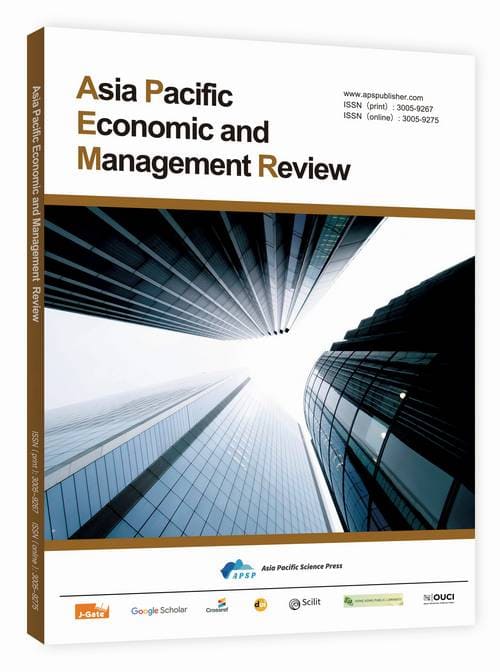A Study on Logistics Efficiency in the Yangtze River Economic Belt Based on a Three-Stage DEA Model
DOI:
https://doi.org/10.62177/apemr.v2i6.762Keywords:
Yangtze River Economic Belt, Logistics Efficiency, Three-stage DEA ModelAbstract
This study employs a three-stage Data Envelopment Analysis (DEA) model to measure and evaluate logistics efficiency in the Yangtze River Economic Belt based on data from 11 provinces and municipalities covering the period 2012–2023. Results indicate that logistics efficiency in the Yangtze River Economic Belt exhibits an overall upward trend; however, development imbalances persist among the upstream, midstream, and downstream regions. Shanghai and Jiangsu exhibit the highest comprehensive technical efficiency, while Chongqing and Sichuan demonstrate the lowest. ② SFA regression analysis reveals that managerial inefficiency is the primary factor causing input redundancy in logistics. The two environmental variables selected—R&D expenditure and regional GDP—exert differing levels of influence on input redundancy. ③ After controlling for environmental variables and random factors, the comprehensive technical efficiency of logistics industries across provinces and municipalities exhibited varying degrees of change. To further enhance logistics efficiency in the Yangtze River Economic Belt, it is essential to strengthen infrastructure development, introduce advanced technologies, and promote regional cooperation to foster coordinated development across the economic belt.
Downloads
References
Xinhua News Agency. (2023, October 12). Xi Jinping presides over symposium on further promoting high-quality development of the Yangtze River Economic Belt, emphasizing: Further promoting high-quality development of the Yangtze River Economic Belt to better support and serve Chinese modernization [Government document]. http://www.qstheory.cn/yaowen/2023-10/12/c_1129913459.htm
China Courts Network. (2020, September 9). Xi Jinping presides over eighth meeting of Central Financial and Economic Affairs Commission, stresses coordinated advancement of modern distribution system to provide strong support for building new development pattern; Li Keqiang, Wang Huning, and Han Zheng attend [Government document]. https://www.chinacourt.org/article/detail/2020/09/id/5449714.shtml
China National Radio Network. (2017, October 27). Xi Jinping: Securing a decisive victory in building a moderately prosperous society in all respects and achieving the great success of socialism with Chinese characteristics for a new era—Report to the 19th National Congress of the Communist Party of China [Government document]. https://news.cnr.cn/native/gd/20171027/t20171027_524003098.shtml
General Office of the State Council of the People’s Republic of China. (2022, December 15). Notice on issuing the 14th Five-Year Plan for modern logistics development: State Council General Office Document [2022] No. 17 [Government document]. https://www.gov.cn/zhengce/content/2022-12/15/content_5732092.htm
People's Daily. (2022, October 16). Holding high the great banner of socialism with Chinese characteristics and striving in unity for the comprehensive construction of a modern socialist country—Report to the 20th National Congress of the Communist Party of China [Government document]. http://www.news.cn/politics/cpc20/2022-10/25/c_1129079429.htm
Gong, X. (2022). Measurement of regional logistics efficiency and analysis of influencing factors. Statistics and Decision Making, 38(12), 112–116.
Kang, T. L., & Wang, X. Q. (2020). Analysis of logistics efficiency and influencing factors under the context of supply-side reform. Journal of Harbin University of Commerce (Natural Science Edition), 36(03), 365–371+378.
Liu, H. J., Guo, L. X., Qiao, L. C., et al. (2021). Spatiotemporal patterns and dynamic evolution of China's logistics industry efficiency. Research in Quantitative Economics and Technical Economics, 38(05), 57–74.
Yin, Y., Ye, C., & Jiang, W. T. (2023). Regional logistics efficiency evaluation and influencing factors based on the Super-SBM-DEA model. Journal of University of Electronic Science and Technology of China (Social Sciences Edition), 25(04), 103–112.
Pei, D. H. (2023). Measurement of logistics efficiency and influencing factors in the Guangdong-Hong Kong-Macao Greater Bay Area urban cluster. Research on Business Economics, (18), 180–183.
Zhu, T. X., Han, J. M., & Wang, H. (2022). Evaluation of regional logistics development characteristics in the Beijing-Tianjin-Hebei Region under the “Dual Circulation” Pattern. Ecological Economics, 38(10), 80–87.
Guo, J. Y. (2022). Ecological efficiency driving mechanism and spatial effect decomposition of the logistics industry: A comparative study based on the Yangtze River Economic Belt and interprovincial regions. Research on Commercial Economics, (05), 108–112.
Zhang, Z. J., Zhang, Z., Wan, M. Y., et al. (2023). Comprehensive evaluation of logistics industry efficiency in cities along the Yangtze River Economic Belt from a high-quality development perspective: Based on a 3-Stage DEA model. Journal of Jiangxi Normal University (Natural Science Edition), 47(04), 350–359+367.
Zhang, Y. S. (2022). Evaluation of regional logistics efficiency and analysis of influencing factors: An empirical study based on the Guangxi Region. Research on Business Economics, (12), 111–114.
Qin, W. (2021). Regional logistics efficiency evaluation and influencing factors: A study based on panel data from prefecture-level cities in Guangdong. Research on Business Economics, (09), 97–100.
Fried, H. O., Lovell, C. A. K., Schmidt, S. S., et al. (2002). Accounting for environmental effects and statistical noise in data envelopment analysis. Journal of Productivity Analysis, 17, 157–174.
Liu, L. Y., Li, M., & Chen, J. X. (2024). Research on low-carbon logistics efficiency in western China based on a three-stage DEA-Malmquist model. Frontier Economy and Culture, (02), 40–47.
Charnes, A., Cooper, W. W., & Rhodes, E. (1978). Measuring the efficiency of decision making units. European Journal of Operational Research, 6(2), 429–444.
Banker, R. D. (1984). Estimating the most productive scale size using data envelopment analysis. European Journal of Operational Research, 17, 35–44.
Wang, W. S., & Kao, X. X. (2021). Research on logistics efficiency measurement in the Bohai Rim Region from a high-quality development perspective: Based on a three-stage DEA model. Business Research, (04), 75–84.
Zhao, Y. X. (2022). Evaluation of logistics efficiency in Jiangsu, Zhejiang, and Shanghai based on a three-stage DEA-Malmquist model [Master’s thesis or Doctoral dissertation]. Hangzhou Dianzi University.
Zhang, H., & You, J. X. (2021). A two-stage efficiency evaluation model for the logistics industry oriented to production processes. Journal of Tongji University (Natural Science Edition), 49(04), 591–598.
Zhang, Y. S. (2022). Regional logistics efficiency evaluation and analysis of influencing factors: An empirical study based on the Guangxi Region. Research on Business Economics, (12), 111–114.
Wu, M. R. (2021). Measurement of innovation efficiency of provincial R&D resources in China. Statistics and Decision Making, (12).
Downloads
How to Cite
Issue
Section
License
Copyright (c) 2025 Jie Zhu, Xin Tian, Jie Yuan, Mingyue Duan

This work is licensed under a Creative Commons Attribution-NonCommercial 4.0 International License.
DATE
Accepted: 2025-10-22
Published: 2025-11-01
















